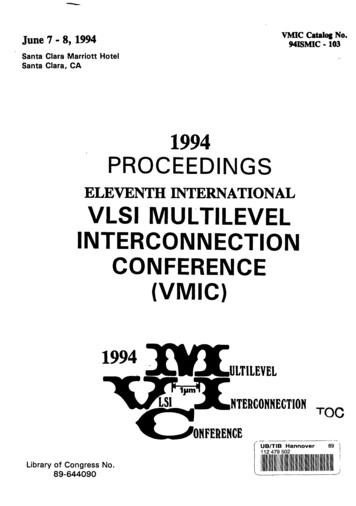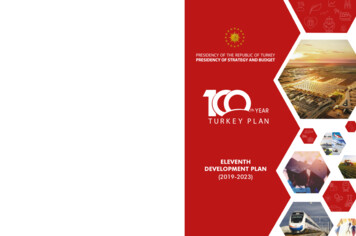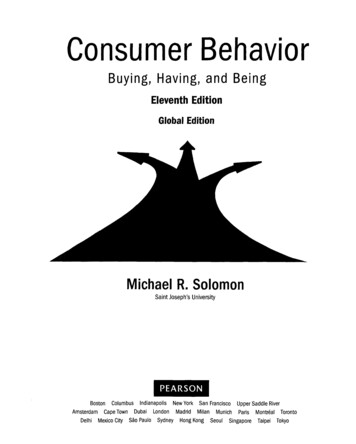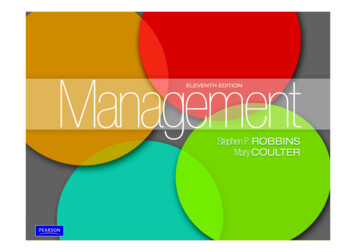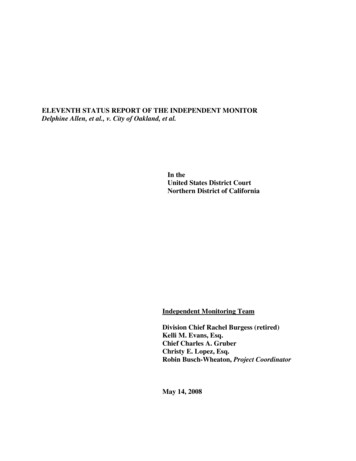
Transcription
Eleventh InternationalConference on HIPIMSAbstract BookNational HIPIMSTechnology Centre UK
Contents3 Surface Engineering: The key to aSustainable Future?4 A low friction route to Net Zero5 Some current and future coatingchallenges in aero-engines6 Surface engineering of the leadingedges of turbomachinery blades7 Surface engineering in RenewableEnergy: Mapping the weather onwear maps8 Understanding tribological contact:how a detailed understanding canhelp design wear resistant material9 SiAlN coating produced withmagnetron sputtering on metalsubstrate for aero-engine andnuclear industry applications10 Thin film refractory plasmonicmaterials: deposition, opticalproperties, and temperaturestability11 HIPIMS of transition metalnitrides for CMOS-compatibleoptoelectronic applications12 Towards Digitalised SurfaceManufacturing: The EPSRC DSMNetworkPlus13 Towards Creation of a DigitalTwin of the Plasma Synthesis ofFunctional Materials by High PowerImpulse Magnetron Sputtering andOther PVD Processes14 Computational Engineering andCyber-Physical Systems15 Unravelling the ion-energydependent structure evolutionand its implications for the elasticproperties of (V, Al)N thin films16 Energy flux measurements atmagnetron sputtering17 Ionization of Sputtered Particles inHiPIMS Discharges18 Multifunctional carbon-basednanocomposite HiPIMS coatings19 Antibacterial Activity of DLC filmswith zinc, copper and silver20 Effect of positive pulse voltage inbipolar reactive HiPIMS on crystalstructure, microstructure andmechanical properties of CrN filmsAbstract Book21 More than 30 year of Evolutionof Cr-Al-N - from conventionalsputtering to HIPIMS for industrialapplications22 12 µm PVD in HiPIMS23 Pulsed Arc plasma of ta-C anddoped ta-C24 Effect of controlled target poisoningon TiAlCN/VCN films deposited inmixed HIPIMS/DCMS discharge25 Measurement of momentumtransfer in ion beam sputtering26 Impact Fatigue and FractureToughness Analysis of CoCrMoAlloy Nitrided using HIPIMS Plasma27 Me-DLC based strain sensitivematerials28 Diamond-like carbon coatings byHIPIMS29 Pulsed Arc non-equilibrium processeffects on the properties of dopedand pure ta-C coatings30 Ionization region model for Ar/Cr ina high power impulse magnetronsputtering discharge31 Ion-induced secondary electronemission coefficient of metalsurfaces analysed in an ion beamexperiment32 PVD coatings for Aluminiumdie casting applications: anexperimental realistic approach33 Investigation of spokes in reactiveAr/N2 atmosphere34 C ontrol of Spokes in MagnetronDischarges35 T ime-Resolved Electron EnergyDistributions and Plasma PotentialsDuring HiPIMS Processes36 H IPIMS deposited nanoscaleCrN/NbN multilayer coating fortribocorrosion resistance37 C haracterisation of a High-PowerImpulse Magnetron Sputtered C/Mo/W Wear Resistant Coating byTransmission Electron Microscopy38 C omplex 3D Nano Structures inHIPIMS Ti1-xAlxN-Coatings, anElectron Microscopic Study39 Controlled reactive HiPIMS:Effective technique for lowtemperature deposition of tunableoxynitrides and thermochromicoxides40 Amorphous and crystalline ReOxthin films deposited by reactiveHiPIMS41 High-speed slot-milling of 304stainless steel by end mill cutterscoated with HiPIMS depositedAlTiN42 Industrialization of PlasmaTechnology: Requirements for thePower Supplies When Moving tothe 100 kW RangeSurface Engineering: The key to a Sustainable Future?David ElliottSurface Engineering Association, Federation House, 10 Vyse Street, Birmingham, B18 6LTSurface engineering provides one of the most important means of engineering product differentiation in terms of quality,performance and life-cycle cost. Its importance to industrial and financial well-being is beyond question. So why issurface engineering so often overlooked by Governments around the world when they are developing manufacturingstrategies for the future?This presentation will examine why surface engineering is so often overlooked and the role that SELF – the SurfaceEngineering Leadership Forum is undertaking to ensure that the UK surface engineering sector remains a world leaderboth academically and industrially.The presentation will focus on the overall goal of SELF to deliver the ecosystem for future growth:43 Presence of a reverse dischargeduring long positive voltage pulsesin a bipolar HiPIMS discharge44 Electron property measurements ina Bipolar HiPIMS discharge by laserThomson scattering45 Diagnosis of Be-Ne-D magnetronplasma operated in bipolar HiPIMSmode46 Bipolar HiPIMS: Correlating plasmaparameters to thin film properties47 The plasma potential structure in abipolar pulsed HiPIMS plasma48 Sputtering onto liquids fornanoparticle synthesis49 The effect of magnetic fieldconfiguration on structural andmechanical properties of TiNcoatings deposited by HiPIMS anddcMS50 HiPIMS : A Side of the Story51 Role of energetic ions in the growthof fcc and ω crystalline phases in Tifilms deposited by HiPIMS52 Time Resolved Ion EnergyDistribution Functions during aHiPIMS Discharge53 Bipolar HiPIMS Thruster: Effectivepropulsion of metal ions forincreased flux and enhancedcoating characteristicsCorresponding author:David ElliottPhone: 44(0)121 237 1123Email: dave.elliott@sea.org.uk3
Abstract BookA low friction route to Net ZeroSam TurnerHigh Value Manufacturing CatapultThere is a call to arms for the manufacturing community in delivering net zero GHG emissions through the productsthat we engineer across energy, transport, infrastructure and the manufacturing processes and supply chains we useto deliver them.Over 60% emissions in manufactured goods are embodied in the materials extraction and primary processing stages.One of the greatest opportunities we have to reduce emissions is to look at life extension and end of life repurposingof engineered products. Surface engineering and advanced coatings play a crucial role in life extension of high valueengineered products in service, and of the tooling and equipment used in the manufacturing processes that producethem. The value proposition for life extensions of critical wear components becomes even more attractive when weconsider a shift toward through life engineering and servitisation of high value assets. Surface coatings also provide theopportunity to enhance bulk properties of less energy intensive materials to deliver required in service performance andreduce embodied emissions for these components.HIPIMS has a clear role to play in enhancing performance and extending life for critical components in some of theevolving clean technology markets. The demand for the solutions that HIPIMS offers should accelerate the innovationand market pull.From a UK perspective the government’s 10-point plan to deliver net zero 2050 and the Industrial Decarbonisationpolicy provide a clear focus and purpose for the manufacturing research and innovation community. At the HVMCatapult we intend to work with world leading researchers in the UK and beyond to develop and fast track thesesolutions into deployment with HIPIMS providing a great example.Corresponding author:Sam TurnerE-mail: sam.turner@hvm.catapult.org.uk4Abstract BookSome current and future coating challenges inaero-enginesR.G WellmanRolls-Royce plcAs the aerospace industry continues the drive towards more fuel efficient and greener engines, without compromisingsafety and performance, materials will continue to be pushed to their limits to deliver these requirements. Combine thiswith increasing the service intervals and one can understand the need for robust tribological solutions to enable bulkmaterials to safely operate in extreme environments. Another aspect to consider is the challenge of a carbon neutralengine by 2050; will this be through the use of bio fuels, electrification or the use of hydrogen as a fuel? Each of whichwill come with its own unique set of challenges that will need to be overcome.From a thermal efficiency perspective hotter and faster is better; hence the relentless increase in turbine entrytemperature such that engines now operate at temperatures exceeding the melting point of nickel based superalloys.This is only possible with the use of internal cooling and thermal barrier coatings. But these systems are now reachingtheir limits; hence the planned introduction of ceramic matrix composites (CMCs) but even these need protection in theform of environmental barrier coatings.On the other hand, improve propulsive efficiency there is a desire to decouple the fan from the LP turbine via agearbox. This power gearbox (PGB) has a whole new set of challenges for the surface engineering and coatingscommunity. What coatings are required and where? How will the oil interact with the surface engineering solutions? Arenew coatings required for the bearings? And if we look towards electrification and electric motors all these questionsare still valid.This paper looks to highlight and discuss some of these issues and the potential for coating technologies to mitigatesome of the current and future challenges faced in achieving design intent for highly complex modern aero-engines.Corresponding author:Richard WellmanE-mail: richard.wellman@rolls-royce.com5
Abstract BookAbstract BookSurface engineering of the leading edges ofturbomachinery bladesSurface engineering in Renewable Energy: Mapping theweather on wear mapsThe national Centre for Advanced Tribology at SouthamptonDepartment of Mechanical & Aerospace Engineering, University of Strathclyde, James WeirBuilding, 75 Montrose St.,Glasgow G1 1XJProfessor Robert JK WoodFaculty of Engineering and Physical Sciences, University of SouthamptonBlade leading edges in turbomachinery are critical to performance and therefore fuel efficiency, emission, noise, runningand maintenance costs. Leading edge damage and therefore roughness is either caused by subtractive processessuch as foreign object damage (bird strikes and debris ingestion) and erosion (hail, rain droplets, sand particles, dust,volcanic ash and cavitation) and additive processes such as filming (from dirt, icing, fouling, insect build-up). Therefore,this paper focuses on the changes of controlling the topography induced by during service to blade leading edgesand the effect of roughness and form on performance and efforts to predict and model these changes. A range ofapplications are considered focused on wind, gas and tidal turbines and turbofan engines.The surface engineering needed and microstructural design as well as the current options to limit roughness changeand protect the leading edge will be presented along with emerging technology that offers protection such as HIPIMScoatings.The main focus will be on water droplet erosion (WDE) with a review of the known physics of droplet impact, currenttesting and modelling capabilities, mechanism-microstructural interactions seen in actual damage of ex-serviceTi-64 fan blades and surface engineering solutions for blade protection. Solutions include HIPIMS CrAlYN/CrNnanostructured multilayer systems, Ti/TiN multilayer and NiCrAlTi PVD coatings, CVD nanostructured W/WC coatingsas well as electroplated hard coatings and the more conventional polyurethane and PACVD boron phosphide coatings.Where possible comparisons in erosion performance will be discussed along with their detailed erosion mechanisms.M M Stack and K PughIn studies of wind and tidal turbine energy conversion, there has been much interest in understanding the effects ofthe environment. This includes parameters relating to rain, hail and UV exposure. As these vary significantly globally,it follows that materials requirements for components associated with such engineering systems may changeaccordingly.In Europe, there is significant energy capture afforded by the high wind speeds surrounding coastal areas in theWestern part of the continent. Whilst these speeds improve energy efficiency, they also have may limit the lifetime ofmaterials associated with wind turbines. This is especially true for leading edges of wind turbine blades.In this paper, a review of laboratory raindrop erosion test results is presented on coated and uncoated surfaces andthe conditions linked to those experienced by turbine blades in the environment. Erosion maps are generated showingpatterns of wastage. Future trends in materials and surface coatings for exposure around coastal areas in Europe arediscussed bearing in mind changes in environmental conditions as experienced in such locations.Recent work where modelling and machine learning is used to predict coated wind turbine blade leading edgedelamination and the effects this has on aerodynamic performance is also presented. The paper concludes thatunderstanding the coated material response to additive and/or subtractive mechanisms and thus the roughness/form evolution over time is essential going forward. This is turn would allow better understanding of the effects thesechanges have on aerodynamic/ hydrodynamic efficiency and the population of stress raisers and distribution of residualstresses that result. These in turn influence erosion rates, fatigue strength and remaining useful life of the blade leadingedge as well as inform new designs, coating selection, maintenance and repair needs.Corresponding author:Robert JK WoodE-mail: r.wood@soton.ac.uk6Corresponding author:M M StackE-mail: margaret.stack@strath.ac.uk7
Abstract BookUnderstanding tribological contact: how a detailedunderstanding can help design wear resistant materialsWM Rainforth, P. Zeng, L. Ma, R. Namus, J. Qi, P. Gong, J. Nutter, X. Xu, J. SharpDepartment of Material Science and EngineeringThe impact of tribology (friction and wear) on the economies of developed nations is a substantial 5-8% of GDP.Friction and wear play a central role in life; in transport, in manufacturing, in process engineering, in medical devicesand in everyday human activities. The tribological performance of a component is a strong function of the interactionbetween the component surfaces and the operating environment, and how the surface changes in response to thecontact stresses. In many cases, the tribo environment can activate chemical or electrochemical reactions. It is thesedynamic changes that determine the success or failure of the component. In many cases, distinct surface structuresare generated by the sliding contact. Of these, the formation of so-called tribofilms is perhaps the most important.The formation of tribofilms can be engineered, for example through additives in oil lubrication. However, evidence ismounting that tribofilms play a crucial role in the success of many components, ranging from articulating surfaces in hipjoints through to ultra-low friction coatings. This talk will show case studies that detail the importance of the formationof tribofilms. Examples will be taken from coatings and bulk materials. The structure of the tribofilm will be consideredin detail, down to the atomic scale. The way in which this can drive the design of wear resistant materials will beconsidered.Corresponding author:WM RainforthE-mail: m.rainforth@sheffield.ac.uk8Abstract BookSiAlN coating produced with magnetron sputtering onmetal substrate for aero-engine and nuclear industryapplicationsPing Xiao1, Zhaohe Gao1, Zhenbo Zhang1, Han Liu1, Xinxin Zhang1, Ying Chen1, Xun Zhang1,Patrick Hill1, Philip Withers1, Justyna Kulczyk-Malecka2 and Peter Kelly212Department of Materials, University of Manchester, UKManchester Metropolitan UniversitySiAlN coatings consisting of Si3N4 and AlN phases with Mo interlayers were produced by magnetron sputter depositionon both Ti and Zr alloys. With the coating on Ti substrate, inter-diffusion and inter-reaction at the interface during cyclicoxidation at 800 C form a multilayer nitride coating system. A novel nitride interlayer exhibits adaptive conformability viamechanical twinning, thereby accommodating the thermal mismatch strain between the coating and substrate. Thisalong with a high bond strength confers excellent thermal cycling life with no cracking, spallation and oxidation of thecoating evident after hundreds of hours of cyclic oxidation ( 40 cycles) in air at 800 C. This work provides a designpathway for a new family of coatings displaying excellent bonding, adaptive conformability and superior environmentalprotection for Ti-alloys at high temperature used in aero-engine industry.The SiAlN coatings were applied to the Zr alloy with the 750 nm or 300 nm Mo interlayers and then were exposedto the steam environment at 1000 C. After 1 hour exposure, no detectable oxide scale forms on SiAlN/Mo (750 nm)coatings whereas SiAlN/Mo (300 nm) forms oxide scale. The downward diffusion of Si followed by relatively fasterdownward diffusion of N generates excessive Si and lean N, forming Si-Si bond in outermost surface of SiAlN, therebyresulting in oxidation. The degradation mechanism of amorphous nitrides is determined by elemental compositioninstead of reported amorphous or crystalline status. The coatings have demonstrated potential for application ofcoated Zr alloy for application in nuclear reactors.Corresponding author:Ping XiaoE-mail: p.xiao@manchester.ac.uk9
Abstract BookAbstract BookThin film refractory plasmonic materials: deposition, opticalproperties, and temperature stabilityHIPIMS of transition metal nitrides for CMOS-compatibleoptoelectronic applicationsDepartment of Materials, Imperial College London, Prince Consort Road, London SW7 2BP, UK1Peter K. Petrov2In this presentation, I will summarise the results of the research workcarried out in my group.Materials such as W, TiN1, and SrRuO3 (SRO)2, have been suggestedas promising alternatives to Au and Ag in plasmonic applications owingto their stability at high operational temperatures. In this study, thin filmsof W, Mo, Ti, TiN, TiON, Ag, Au, SrRuO3 and SrNbO3 with thicknessesranging from 50 to 105 nm are deposited on MgO, SrTiO3 and Sisubstrates by e-beam evaporation, RF magnetron sputtering1 and pulsedlaser deposition 2,3,4. Their properties are investigated to evaluate theirpotential use in the advancing field of plasmonics and nanophotonics bymeans of AFM, XRD, spectroscopic ellipsometry, and DC resistivity.All samples are measured before and after annealing in air attemperatures ranging from 300 to 1000 C for one hour, to establishthe maximum cycling temperature and potential longevity at elevatedtemperatures for each thin film materialv. It is found difficult to producereliably the commonly reported refractory materials W, Mo and Ti, owingto the apparent influence of surface oxides. Meanwhile, the real part ofthe dielectric permittivity of Au was found to be stable up to 500 C whendeposited on MgO, though the optical losses increased gradually withannealing temperature. After annealing at 600 C, significant changesto the morphology of the Au film were shown to result in a loss ofconnectivity across the film.Ryan Bower1,Daniel Loch2, Qiaomu Yao1, Papken Hovsepian2, Arutiun Ehiasarian2,Peter Petrov1Imperial College London, London, United KingdomSheffield Hallam University, Sheffield, United KingdomTransition metal nitrides (TMNs) display increased mechanical stability, thermal stability and spectral tunability whencompared to the noble metals gold and silver and as such have emerged as viable alternative materials for plasmonicand optoelectronic applications.1,2In order to successfully develop TMN-based optoelectronic devices it is necessary to deposit high quality thin filmsat CMOS compatible temperatures. Furthermore, deposition parameters of TMN thin films must be correlated withfilm optical properties in order to determine the suitability of various transition metal nitrides for use within a range ofapplications and operating environments. Key factors to consider include temperature stability and compatibility withapplication-specific substrate materials.Fig 1. The proposed operating regimesfor the investigated materials [5].In this work, we investigate the applicability of transition metal nitride thin films (TiN, NbN, Ti(1-x)NbxN) for use withinplasmonic and optical devices. TMN thin films were deposited by High-Power Impulse Magnetron Sputtering (HIPIMS)onto a variety of semiconductor and industrial-standard substrates including Si, MgO, glass and steel. Opticalproperties were characterised using spectroscopic ellipsometry and correlated with the crystalline structure and surfacemorphology of the thin films. Additionally, the spectral tunability of these materials was investigated with respect to filmstoichiometry.References[1] Wells, M. P. et al. Temperature stability of thin film refractory plasmonic materials. Opt. Express 26, 15726 (2018).[2] Braic, L. et al. Titanium Oxynitride Thin Films with Tunable Double Epsilon-Near-Zero Behavior for NanophotonicApplications. ACS Appl. Mater. Interfaces 9, 29857–29862 (2017).The optical properties of both TiN and TiON have been observed to change significantly upon annealing in the airbefore a loss of metallic behaviour after annealing at 500 C. However, unlike the noble metals, changes to the materialproperties appear a result of oxidation rather than changes to the surface morphology. It may therefore be concludedthat, while Au may be more suitable for high temperature applications in air, TiN and TiON are better suited to hightemperature applications operating under vacuum conditions or after suitable protective capping layers are identified.Finally, the optical properties of SNO and SRO are considered, with the results showing that metallic behaviour is lostin SNO after annealing at 400 C due to a phase transition while being retained in SRO after annealing at 800 C.However, the degradation above this temperature appears a result of the agglomerate formation of the film. Therefore,although SRO may be an attractive alternative to Au for some high temperature applications, TiN and TiON may beexpected to exhibit superior thermal stability in an encapsulated environment.References1L Braic et al, ACS Appl. Mater. Interfaces 2017, 9, 29857 298622L Braic, et al Sci. Rep. 5, 9118 (2015)3Wells et al, Adv. Optical Mater. 2017, 17006224Wells et al, Vol. 8, No. 7 1 Jul 2018 OPTICAL MATERIALS EXPRESS 18125Wells et al, Vol. 26, No. 12 11 Jun 2018 OPTICS EXPRESS 15736Corresponding author:Peter K. PetrovE-mail: p.petrov@imperial.ac.uk10Corresponding author:Ryan BowerE-mail: r.bower16@imperial.ac.uk11
Abstract BookTowards Digitalised Surface Manufacturing:The EPSRC DSM NetworkPlusAllan MatthewsThe University of ManchesterAbstract BookTowards Creation of a Digital Twin of the Plasma Synthesisof Functional Materials by High Power Impulse MagnetronSputtering and Other PVD ProcessesA.P. Ehiasarian1, A. Sugumaran1, P.Eh. Hovsepian1, C. Davies2, P. Hatto2National HIPIMS Technology Centre, Sheffield Hallam University, Howard St, Sheffield,S1 1WB, UK.1A study by a Special Interest Group (SIG), set up by the KTN, identified that compared to other High ValueManufacturing sectors, the coatings industry has tended to lag behind in terms of the level of digitalisation achieved.This, coupled with the drive towards Industry 4.0 and “Made Smarter” thinking has prompted moves within UKacademia and industry to encourage the wider adoption of digitalisation. The Engineering and Physical SciencesResearch Council (EPSRC) has supported the creation of an academic network (the Digitalised Surface Manufacturing(DSM) NetworkPlus) and at the same time, industry has joined forces to create “SELF” (the Surface EngineeringLeadership Forum). This talk explains the background to the DSM Network, its mode of operation and provides aninsight into its progress. This includes the distribution of biddable research funds, regular webinars and discussiongroups as well as engagement with leading laboratories around the world to identify best practice and make thatavailable to UK academics and industrial practitioners.2Ionbond UK Ltd, No 1 Industrial Estate, Consett, Co Durham, DH8 6TS, UKOptical emission spectroscopy (OES) has been used to monitor all stages of both HIPIMS and conventional magnetronsputtering processes and has been shown to provide a robust method of determining process repeatability with thepotential to provide a reliable means of process control for quality assurance purposes. Using suitably designed probesit has been possible to identify relevant emission lines for monitoring the progress of chamber evacuation, substrate/source cleaning/conditioning, together with coating related aspects such as thickness, composition and morphologicaldevelopment of film and interlayer deposition. In addition, OES has been shown to provide a reliable means ofsystem condition-monitoring, including early identification of air and water leaks, to support process optimisation andequipment utilisation.The methodology has been shown to be highly relevant to sputter processes, including HIPIMS with a range ofmagnetron magnetic field configurations, for the deposition of ‘conventional’ nitride and carbonitride coatings, i.e.those of fixed composition. Challenges have been experienced with identifying suitable parameters for monitoring andcontrol of films deposited using varying processing conditions, e.g. continually changing gas composition/pressure,frequently used in the control of, e.g. decorative coatings. Work is underway to determine if and how machine learningprotocols can be applied to facilitate and optimise monitoring and control of these and other processing activities,including coatings development and the use of alternative deposition techniques, e.g. arc evaporation.The work reported provides essential elements for the creation of a digital twin of the sputtering process which canbe used both to monitor the process and predict outcomes such as sample and chamber wall contamination whilstincorporating physical models allowing calculation of film thickness in real time and the prediction of film texture.Corresponding author:Allan MatthewsE-mail: allan.matthews@manchester.ac.uk12Corresponding author:Peter HattoE-mail: peter.hatto@ionbond.com13
Abstract BookComputational Engineering and Cyber-Physical SystemsChristoph HerrmannFraunhofer-Institut für Schicht- und Oberflächentechnik ISTCoatings and surface engineering are essential enablers for sustainable products and processes. They have thepotential to drastically reduce environmental impacts per functional unit. A holistic approach is required to supportengineering decisions from a system perspective and to avoid problem shifting. Such a holistic approach spans fromprocess and machine level to factory level.Two individual process examples for digitalization are shown. Using sputtering deposition for precision optics theEOSS(R) from Fraunhofer IST is a great example for application of digital data and digital twin. Using real timemonitoring and feedback control the coating process is tuned during operation. The second example considers thetensidic cleaning line at Fraunhofer IST where all data is provided in real time digitally. The wide data basis is used fortrend analysis and predictions.Abstract BookUnravelling the ion-energy-dependent structure evolutionand its implications for the elastic properties of (V,Al)N thinfilmsSoheil Karimi Aghdaa,, Denis Musicb, Yeliz Unutulmazsoyc, Heng Han Suaa, Stanislav Mráza,Marcus Hansa, Daniel Primetzhoferd, André Andersc,e and Jochen M. SchneideraaMaterials Chemistry, RWTH Aachen University, Kopernikusstr. 10, 52074 Aachen, GermanyDepartment of Materials Science and Applied Mathematics, Malmö University, 20506 Malmö,Swedenb cLeibniz Institute of Surface Engineering (IOM), Permoserstr. 15, 04318 Leipzig, GermanyDepartment of Physics and Astronomy, Uppsala University, Lägerhyddsvägen 1, 75120Uppsala, Swedend eFelix Bloch Institute, Leipzig University, Linnéstr. 5, 04103 Leipzig, GermanyIon irradiation-induced changes in the structure and mechanical properties of metastable cubic (V,Al)N deposited byreactive high power pulsed magnetron sputtering are systematically investigated by correlating experiments and theoryin the ion kinetic energy (Ek) range from 4 to 154 eV. Increasing Ek results in film densification and the evolution from acolumnar (111) oriented structure at Ek 24 eV to a fine-grained structure with (200) preferred orientation forEk 104eV. Furthermore, the compressive intrinsic stress increases by 336 % to -4.8 GPa as Ek is increased from 4 to 104 eV.Higher ion kinetic energy causes stress relaxation to -2.7 GPa at 154 eV. These ion irradiation-induced changes inthe thin film stress state are in good agreement with density functional theory simulations. Furthermore, the measuredelastic moduli of (V,Al)N thin films exhibit no significant dependence on Ek. The apparent independence of the elasticmodulus on Ek can be rationalized by considering the concurrent and balancing effects of bombardment-inducedformation of Frenkel pairs (causing a decrease in elastic modulus) and evolution of compressive intrinsic stress (causingan increase in elastic modulus). Hence, the evolution of the film stresses and mechanical properties can be understoodbased on the complex interplay of ion irradiation-induced defect generation and annihilation.Corresponding author:Christoph HerrmannE-mail: g author:Jochen M. SchneiderE-mail: schneider@mch.rwth-aachen.de15
Abstract BookEnergy flux measurements at magnetron sputteringH. Kersten1, J. Cipo1, F. Schlichting1, D. Meyners2, L. Thormälen2, F. Zahari2, R. Marquardt2,H. Kohlstedt2U Kiel, IEAP, Leibnizstrasse 19, D-24098 Kiel, Germany2U Kiel, TF, Kaiserstrasse 02, D-24098 Kiel, Germany1A summary is given of different elementary processes influencing the thermal balance and energetic conditions ofsubstrate surfaces during magnetron sputtering. The discussed mechanisms include heat radiation, kinetic andpotential energy of charged par
3 Contents Abstract Book 3 Surface Engineering: The key to a Sustainable Future? 4 A low friction route to Net Zero 5 Some current and future coating challenges in aero-engines 6 Surface engineering of the leading edges of turbomachinery blades 7 Surface engineering in Renewable Energy: Mapping the weather on wear maps 8 Understanding tribological contact: how a detailed understanding can

